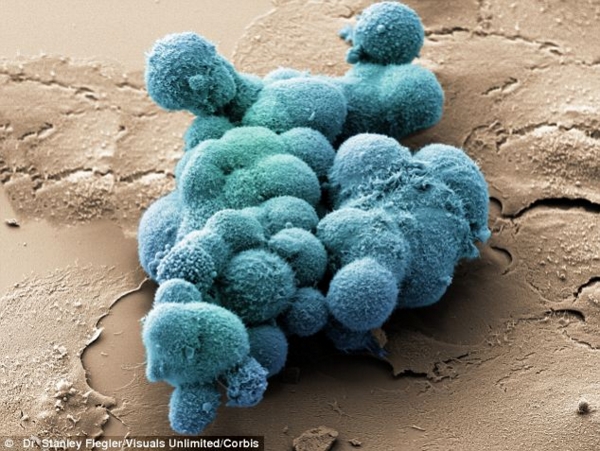- Schoolboy invents early test for pancreatic cancer that killed Steve Jobs
- Jack Andraka’s new test detects pancreatic cancer earlier than any other
- Deadly disease currently kills 19 out of 20 within five years
- He claims his invention could raise survival rates to ‘close to 100 per cent’
 A 15-year-old schoolboy could save millions of lives after he invented a new, low-cost test that can detect the early stages of a deadly form of cancer.
A 15-year-old schoolboy could save millions of lives after he invented a new, low-cost test that can detect the early stages of a deadly form of cancer.
Jack Andraka from Crownsville, Maryland, developed a simple dip-stick test for levels of mesothelin, a biomarker for early stage pancreatic cancer found in blood and urine.
It promises to revolutionise treatment of the disease, which currently kills 19 out of 20 sufferers after five years – largely because its so difficult to detect until its final stages.
Jack’s invention, for which he was last month awarded the grand prize of $75,000 in scholarship funds at the 2012 Intel Science Fair, means that patients now have a simple method to detect pancreatic cancer before it becomes invasive.
His novel patent-pending sensor has proved to be 28 times faster, 28 times less expensive, and over 100 times more sensitive than current tests.
Thanks to the test, pancreatic cancer patients could now get an early earning to seek medical help when it still has a chance of working, which could, he claims, potentially bump up survival rates to ‘close to 100 per cent’.
The test works in a similar way to diabetic testing strips, with his paper strips using only a drop of blood to determine whether patients carry the mesothelin biomarker.
 It is said to be over 90 per cent accurate, practically instant – and costs only 3 cents.
It is said to be over 90 per cent accurate, practically instant – and costs only 3 cents.
And what’s more, his simple test can also be used to detect ovarian and lung cancer, and it could be easily altered to detect the biomarkers of a range of other conditions.
‘Whats so cool about that is its applicability to other diseases for example other forms of cancer, tuberculosis, HIV, environmental contaminants like E Coli, salmonella,’ Jack told Take Part.
‘All for three cents for a test that takes five minutes to run.’
Jack was moved to come up with the test after a family friend passed away from pancreatic cancer, but it was as he surreptitiously read a journal article about carbon nanotubes in a biology lesson that he had his ‘epiphany’.
But that eureka moment was not enough; the persistent teenager was rejected by 197 scientists he solicited for help with his research – with some plainly telling him his idea simply would not work.
Finally Dr Anirban Maitra, a professor of pathology and oncology at Johns Hopkins University, agreed to give him space in the lab and mentored him through the process of developing the test.
To create the test, Jack mixed human mesothelin-specific antibodies with single-walled carbon nanotubes used the product to coat strips of ordinary filter paper.
 The nanotubes make the paper conductive, but when mesothelin is applied the antibodies would bind to the biomarker and enlarge, spreading the nanotubes apart and changing the strips’ electrical properties.
The nanotubes make the paper conductive, but when mesothelin is applied the antibodies would bind to the biomarker and enlarge, spreading the nanotubes apart and changing the strips’ electrical properties.
The more mesothelin present, the more antibodies bind and grow, and the weaker the electrical signal becomes – allowing scientists to accurately measure the levels of the biomarker.
Now the teenage prodigy has plans to mass-market the tests and make them widely available to the public, which he believes could alter the balance of power in medicine.
‘Essentially what Im envisioning here is that this could be on your shelf at your Walgreens, your Kmart,’ he said.
‘Lets say you suspect you have a condition you buy the test for that. And you can see immediately if you have it.
‘Instead of your doctor being the doctor, youre the doctor.’
Written by Damien Gayle and published at The Daily Mail, January 29, 2013.
FAIR USE NOTICE: This site contains copyrighted material the use of which has not always been specifically authorized by the copyright owner. We are making such material available in our efforts to advance understanding of environmental, political, human rights, economic, democracy, scientific, and social justice issues, etc. We believe this constitutes a ‘fair use’ of any such copyrighted material as provided for in section 107 of the US Copyright Law. In accordance with Title 17 U. S. C. Section 107, the material on this site is distributed without profit to those who have expressed a prior interest in receiving the included information for research and educational purposes. For more information go to: http://www. law. cornell. edu/uscode/17/107. shtml
